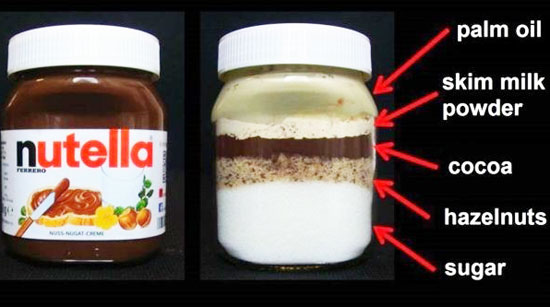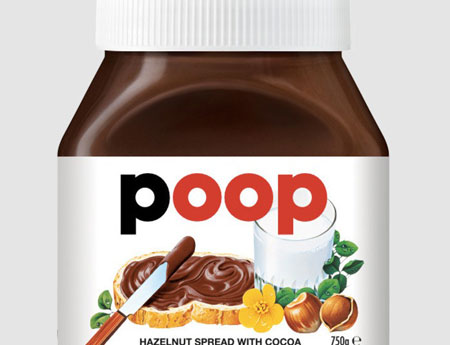What Really Goes into a Jar of Nutella Will Shock You
An image shared on Reddit claims to show what goes into making a jar of Nutella – and if you thought hazelnuts would be high up on the list of ingredients, be prepared to be shocked.

Who doesn’t love Nutella – the world’s most addictive chocolate hazelnut spread? Nutella, invented by the world’s richest chocolatier and the brain behind Kinder Surprise and Ferrero Rocher, have had children and adults alike hooked on it for years.
The massive craze for the giant Nutella tubs is reflected in many astonishing facts. You could cover the Great Wall of China 8 times with the number of Nutella jars sold in a year. You could circle the globe 1.4 times with the amount of Nutella produced every year. While one jar of Nutella is sold every 2.5 seconds throughout the world, all of the Nutella sold in a year could be spread over more than 1,000 soccer fields. This year, on February 5th, chocoholics worldwide celebrated the 10th annual World Nutella Day…
Nonetheless, there is a dark and sinister side to Nutella that its die-hard lovers are oblivious to. Someone in Germany shared an image on Reddit, claiming to show what goes into making a jar of Nutella – and if you thought hazelnuts would be high up on the list of ingredients, be prepared to be shocked.
The globally adored chocolate spread contains palm oil, cocoa, hazelnuts, skimmed milk powder, sugar, soy lecithin and vanillin. The ingredients may make Nutella delicious, but their quantity certainly does not make Nutella nutritious.
Sugar
A serving of Nutella (37 grams or two tablespoons) contains a whopping 21 grams of sugar and 200 calories. So, for a standard 400 gram jar, that’s 227.2 grams of sugar – which means white sugar makes up more than half of Nutella’s weight; 58% to be precise. For an adult weighing a normal weight, the World Health Organization recommends no more than 25 grams of added sugar per day. For the uninitiated: sugar causes coronary heart disease, insulin spikes, type II diabetes and cancer.
Nutritionist Kristen Beck told news.com.au the biggest problem with Nutella is that it is still marketed as a wholesome healthy spread targeted at children – when it’s clearly not.
“The thing about Nutella is that it has been marketed as a health food based on its’ hazelnut and cocoa content. But the reality is, it contains way more refined white sugar than anything else and that’s why it tastes so good. Cocoa is rich in antioxidants, and hazelnuts are healthy and contain healthy fats – but any benefit from these ingredients would be drowned out essentially by the sugar and palm oil content.”
Palm Oil
Nutella is 32% fat, most of which is palm oil – the cheapest oil on the market, more carcinogenic than other vegetable oils. In May 2016, the European Food Safety Authority (EFSA) claimed that palm oil is potentially carcinogenic when processed at high temperatures, and generates more of a potentially carcinogenic contaminant than other vegetable oils when refined at temperatures above 200 degrees Celsius.

In December 2016, a study partly funded by UK charity Worldwide Cancer Research claimed a link between palm oil and the rapid spread of cancer. Mice with a high fat diet and large amounts of palmitic acid (a large component of palm oil) developed the most aggressive cancer spread. The new revelations led to reports that Nutella may be pulled from grocery store shelves throughout Europe after retailers threatened to boycott the cancer-causing hazelnut chocolate spread.
However, Ferrero, the maker of Nutella, hit back at claims that the hazelnut chocolate spread carries cancer risks, stating that when consumed with a balanced diet Nutella is still perfectly safe to eat. Insisting that the decision to keep palm oil in Nutella, despite safety fears, is about high quality and not cost, Ferrero launched an advertising campaign to reassure customers that the sustainable palm oil in Nutella is heated only to safe temperatures that do not result in contaminants.
The official company statement reads:
“One of Ferrero’s core nutritional beliefs is that small portion sizes help people to enjoy their favourite foods in moderation. The labelling on Nutella provides simple and clear nutritional information per 15g portion, or two heaped teaspoons, as well as per 100g. The ingredients are also listed on the Nutella website. The labelling on all our products enables consumers to make informed choices and helps ensure that Nutella can be enjoyed as part of a balanced diet.”
In 2012, Ferrero was sued for health-washing in the United States in a class action lawsuit for “misleadingly advertising Nutella as a healthy breakfast food”. The lawsuit was settled for just over $3 million; the settlement also required Ferrero to make changes to Nutella’s labelling and marketing.
Will you ignore the horrible truth behind Nutella or will you choose to stop eating the cancer-causing chocolate spread?
yogaesoteric
April 18, 2017
Also available in:
 Română
Română
